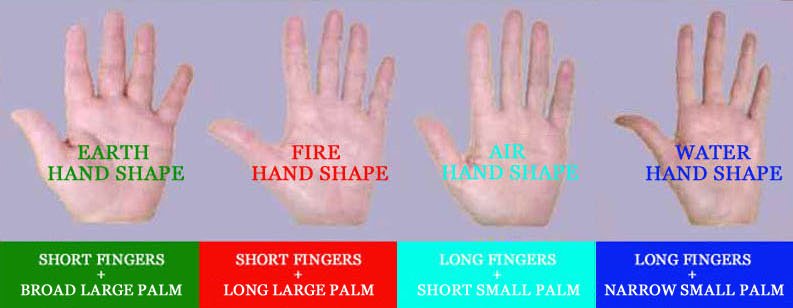|
• The hand in DOWN SYNDROME! _- Down syndrome case study 1 _- Down syndrome case study 2 • The hand in FRAGILE-X SYNDROME! _- Fragile-X syndrome case study 1 _- Fragile-X syndrome case study 2 _(In people with autism 2% to 6% have Fragile-X syndrome!) • The hand in DIABETES MELLITUS! • The hand in RHEUMATOID ARTHRITIS! • The hand in PSORIASIS! • The hand in SCHIZOPHRENIA! • The hand in EXTRAVERSION & INTROVERSION • MARFAN SYNDROME hand test! • The hand lines (palmar creases) • The simian line • The Sydney line • Fingerprints (+ dermatoglyphics) • The Hypothenar whorl • What can finger length reveal? • The 5th finger (pinky) • The fingernail tutor
FINGER LENGTH, PALM LENGTH & PALM BREADTH DEFINE THE 4 ELEMENTAL HAND SHAPES! (REVISED: SEPTEMBER 6, 2014) Biometric statistics presented inside the 'Handbook of Normal Physical Measurements' (Hall, 1989) indicate that the estimates for 'medium proportions' presented in this article are (very) accurate for the PB/PL dimension; however, the estimates for medium FL/PL proportion (and medium FL/PB) turn out to be far too high. Therefore the first picture inside this article has been modified (now featured also with orange dots representing the official biometric 'medium' standards from the scientific literature). In the field of hand reading is finger length considered as an important point of reference regarding the assessment of hand shape. A new study is presented here based on 16 hand shape examples that were presented in various books about hand reading. The study demonstrates how each of the 4 hand shapes varies significantly from the other hand shapes in at least 3 hand dimensions that used to describe the hand shape proportions - which include: finger length, palm width & palm length. And simple specific guidelines are presented to identify the 4 elemental hand shapes... AND mixed hand shapes. The new study points out that each of the 4 elemental hand shapes can be recognized by it's proportions relative to each other. The picture below describes how to assess elemental hand shape via finger length, palm breadth and palm length. For each hand shape a proportional formula (where finger length remains fixed at 8 cm) is presented, featured with a 'shape profile' which represents the essential characteristics that are required for each hand shape. 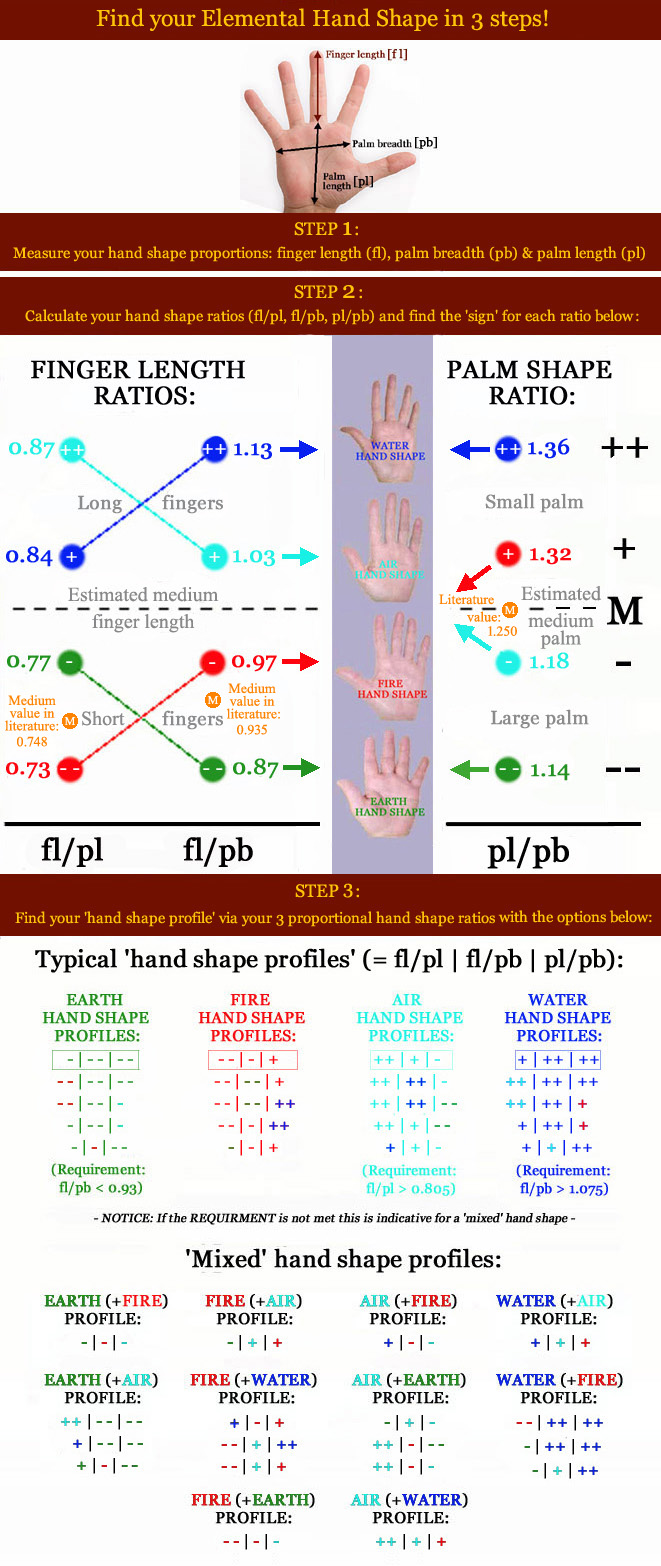
The first hand type system was probably presented as early as the 1st half of the 19th century, when Carl Gustav Carus presented his 4 hand types system - including: the elementary-, motoric-, sensitive-, and psychic hand. In the 2nd half of the 19th century the d'Arpentigny's model describing 7 hand types (six archetypal types + one mixed type) became the most popular model for a very long time. Then halfway the 20th century Various hand research projects presented by the Polish psychologist Charlotte Wolff have been recognized as representing a significant milestone in the field of (scientific) hand reading. Her studies e.g. described how 'hand form' (hand shape) often provides significant clues regarding mental deficiencies, learning problems & psychiatric disorders in the hands of an individual. In the 2nd half of the 20 century the so-called 'elemental hand shapes' (a.k.a. the Wu-Hsing method) became a popular (philosophical) model for studying finger length + palm shape in the perspective of basic character- and personality traits. This model (just like d'Arpentigny's model) is still being mentioned quite often in books about hand reading today. 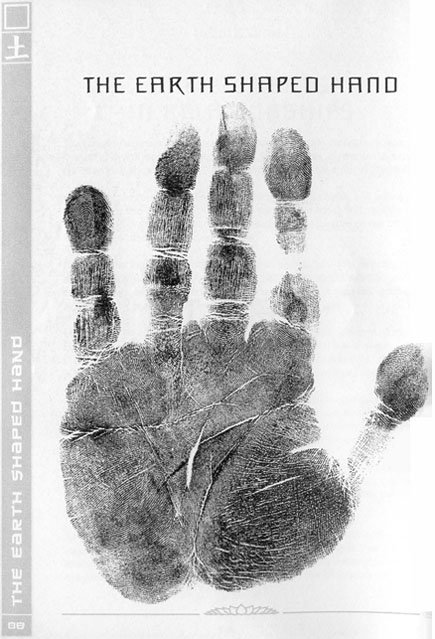
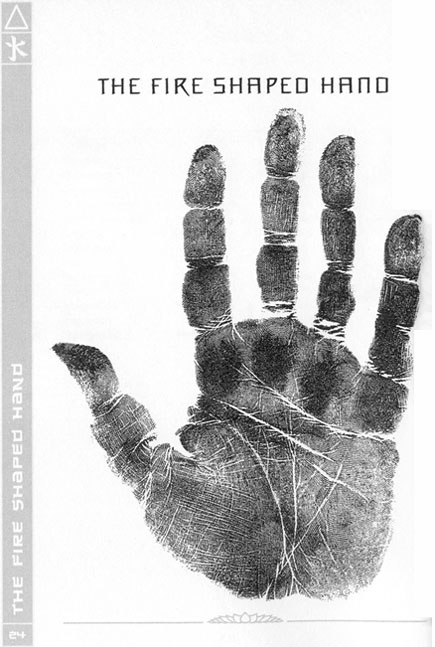
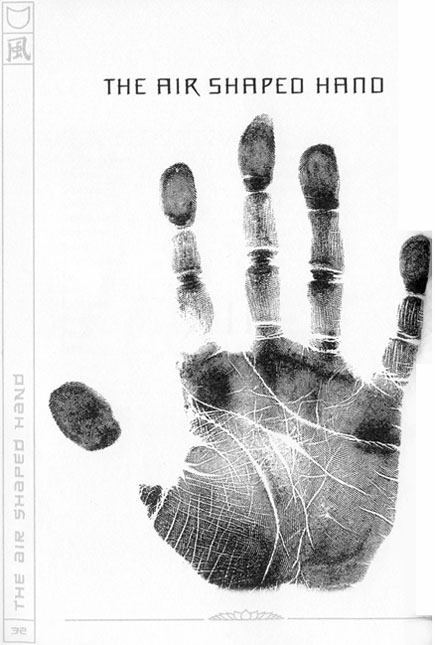
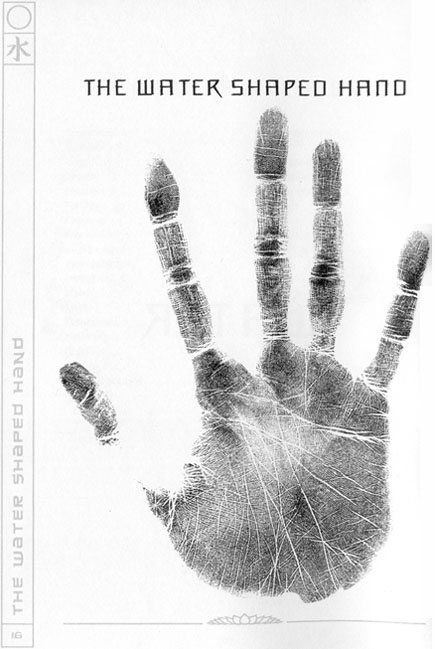
The 4 hands above (presented in Jennifer Hirsch's "God Given Glyphs") represent typical examples for each of the 4 hand shapes. The first example displays an earth hand shape because of the very short fingers (compared to both palm length and palm breadth) + the very pronounced palm breadth (versus palm length). The proportional formula for this hand is: '8 | 9.4 | 10.5', which results in a shape profile: '- | - - | - -', which is typical for a pure 'earth hand shape'. So far the 'elemental hand shapes' were generally classified through an assessment of finger length (short fingers versus long fingers) combined with palm shape (square palm versus rectangle palm). However, in time most authors had developed their own rules accordingly how to decide whether fingers are 'short' or 'long', and whether the palm shape is 'square' or 'rectangular'. And there has been little agreement about the criteria. Therefore a new model has been developed based on precise measurements of three hand dimensions (finger length, palm length & palm breadth) in 16 hand examples that were presented in books by 4 hand reading authors (Fred Gettings, Lori Reid, Johnny Fincham, and Jennifer Hirsch - more details are presented in the picture at the bottom of this page). The study reveals that all 4 hand shapes vary from each other on all 3 hand dimensions. Specific criteria have been developed in order to discriminate the 4 hand shapes from each other on the 3 hand dimensions. The chart below presents a 3-step method for identifying the elemental hand shape for a hand (based on measurements for: finger length, palm length & palm breadth). 

The charts above describe the 'story' of this study: the values in the left chart resulted from the 'average' finger coordinates for each of the 4 hand types which are presented in the right chart (based on hand shape examples taken from the 4 books - the titles are listed in the right picture). While finger length had so been described to be either 'short' or 'long', the results of this study indicate that finger length in the 4 hand shapes can be described by details as follows: FINGER LENGTH PROPORTIONS IN THE 4 ELEMENTAL HAND SHAPES: - Finger length in earth hand shape = slightly short to palm length [-] and very short to palm breadth [--] (+ very short palm length to palm breadth [--]) - Finger length in fire hand shape = very short to palm length [--] and slightly short to palm breadth [-] (+ slightly long palm length to palm breadth [+]) - Finger length in air hand shape = very long to palm length [++] and slightly long to palm breadth [+] (+ slightly short palm length to palm length [-]) - Finger length in water hand shape = slightly long to palm length [+] and very long to palm breadth [++] (+ very long palm length to palm breadth [++]) How to find out whether fingers are 'slightly short' or 'very short'? And how to identify by detail if fingers are 'slightly long' or 'very long'? The answers are found in the criteria which have risen from this study, which are described by detail below. (NOTICE: The criteria below resemble the visual presentation in the picture that describes the 3 step method for finding elemental hand shape, where the first profile for each hand shape represent the 'pure' hand shape) 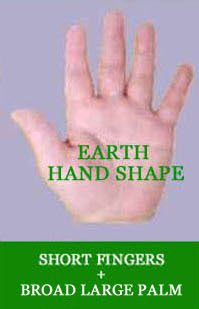
FINGER LENGTH & PALM SHAPE REQUIREMENTS FOR AN EARTH HAND SHAPE! Any EARTH hand shape should meet the following 4 requirements: ['<' means: smaller then; '>' means: larger then] 1) Finger length < 80% of palm length [=> SHAPE CODE E1 = - or - -]; 2) Finger length < 100% palm breadth [=> SHAPE CODE E2 = - - or -]; 3) Palm breadth > 80% of palm length [=> SHAPE CODE E3 = - - or -]; 4) IF finger length < 75% of palm length, then finger length requires to be < 92% palm breadth (otherwise it's a 'fire (+ earth) hand shape'). Finally, the 'pure' EARTH hand shape has a SHAPE PROFILE: - | - - | - - 1) 75% of palm length < finger length < 80% of palm length [=> SHAPE CODE E1 = -] 2) Finger length < 92% palm breadth [=> SHAPE CODE E2 = - -] 3) Palm breadth > 86% of palm length [=> SHAPE CODE E3 = - -] NOTICE: The following guidelines describe how to evaluate if a hand has an EARTH hand shape: - After finding the SHAPE PROFILE for a hand you can compare it with the 'pure' EARTH profile: - | - - | - -; - If the SHAPE PROFILE of the hand exactly matches the 'pure' EARTH profile (- | - - | - -) then the hand has a typical EARTH hand shape; - If the SHAPE PROFILE has a variant of the 'pure' EARTH profile (which can be described as a code combination with at least one '-' sign in each of the 3 codes, and at least one of those requires to be '- -'), then the hand is described as an EARTH hand shape as well; - Any other SHAPE PROFILE indicates that EARTH hand shape is not dominant for the hand. 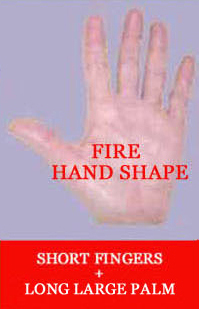
FINGER LENGTH & PALM SHAPE REQUIREMENTS FOR A FIRE HAND SHAPE! ['<' means: smaller then; '>' means: larger then] 1) Finger length < 80% of palm length [=> SHAPE CODE F2 = - - or -]; 2) Finger length < 100% palm breadth [=> SHAPE CODE F1 = - or - -]; 3) Palm breadth < 80% of palm length [=> SHAPE CODE F3 = + or + +]. Finally, a 'pure' FIRE hand shape has a SHAPE PROFILE: - - | - | + 1) Finger length < 75% palm length [SHAPE CODE F1 = - -] 2) 92% of palm breadth < finger length < 100% of palm breadth [SHAPE CODE F2 = -] 3) 75% of palm length < palm breadth < 80% of palm length [SHAPE CODE F3 = +] NOTICE: The following guidelines describe how to evaluate if a hand has a FIRE hand shape: - After finding the SHAPE PROFILE for a hand you can compare it with the 'pure' EARTH profile: - - | - | +; - If the SHAPE PROFILE of the hand exactly matches the 'pure' FIRE profile (- -| - | +) then the hand has a typical FIRE hand shape; - If the SHAPE PROFILE has a variant of the 'pure' FIRE profile (which can be described as a code combination where the first two codes include at least one '-' sign, and the third sign includes at least one '=' sign), then the hand is described as a FIRE hand shape as well; - Any other SHAPE PROFILE indicates that FIRE hand shape is not dominant for the hand. 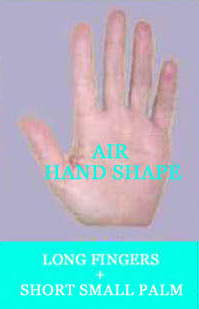
FINGER LENGTH & PALM SHAPE REQUIREMENTS FOR AN AIR HAND SHAPE! ['<' means: smaller then; '>' means: larger then] 1) Finger length > 80% of palm length [=> SHAPE CODE A1 = ++ or +]; 2) Finger length > 100% palm breadth [=> SHAPE CODE A2 = + or ++]; 3) Palm breadth > 80% of palm length [=> SHAPE CODE A3 = - or - -]. Finally, a 'pure' AIR hand shape has a SHAPE PROFILE: ++ | + | - 1) Finger length > 85.5% palm length [SHAPE CODE A1 = ++] 2) 100% of palm breadth < finger length < 108% of palm breadth [SHAPE CODE A2= +] 3) 80% of palm length < palm breadth < 86% of palm length [SHAPE CODE A3 = -] The following guidelines describe how to evaluate if a hand has an AIR hand shape: - After finding the SHAPE PROFILE for a hand you can compare it with the 'pure' AIR profile: ++ | + | -; - If the SHAPE PROFILE of the hand exactly matches the 'pure' AIR profile (++ | + | -) then the hand has a typical AIR hand shape; - If the SHAPE PROFILE has variant of the 'pure' AIR profile (which can be described as a code combination where the first two codes include at least one '+' sign, and the third sign includes at least one '-' sign), then the hand is described as an AIR hand shape as well; - Any other SHAPE PROFILE indicates that AIR hand shape is not dominant for the hand. 
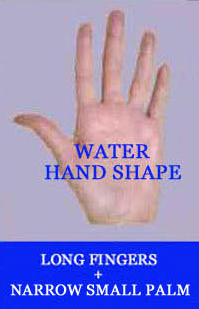
FINGER LENGTH & PALM SHAPE REQUIREMENTS FOR A WATER HAND SHAPE! ['<' means: smaller then; '>' means: larger then] 1) Finger length > 80% of palm length [=> SHAPE CODE W1 = + or ++]; 2) Finger length > 100% palm breadth [=> SHAPE CODE W2 = ++ or +]; 3) Palm breadth < 80% of palm length [=> SHAPE CODE W3 = ++ or +]; 4) IF finger length > 85% of palm length, then finger length requires to be > 108% palm breadth (otherwise it's a 'air (+water) hand shape'). Finally, the 'pure' WATER hand shape has a SHAPE PROFILE: + | ++ | ++ 1) 80% of palm length < finger length < 85.5% of palm length [=>SHAPE CODE W1= +] 2) Finger length > 108% palm breadth [=> SHAPE CODE W2 = ++] 3) Palm breadth < 75% of palm length [=> SHAPE CODE W3 = ++] The following guidelines describe how to evaluate if a hand has a WATER hand shape: - After finding the SHAPE PROFILE for a hand you can compare it with the 'pure' WATER profile: + | ++ | ++; - If the SHAPE PROFILE of the hand exactly matches the 'pure' WATER profile (+ | ++ | +) then the hand has a typical WATER hand shape; - If the SHAPE PROFILE has variant of the 'pure' WATER profile (which can be described as a code combination with at least one '+' sign in each of the 3 codes, and at least one of those requires to be '++'), then the hand is described as a WATER hand shape as well; - Any other SHAPE PROFILE indicates that WATER hand shape is not dominant for the hand. In many people the hand dimensions do not meet enough requirements to be described as one single hand shape type. Then one can speak by principle of a 'mixed' hand shape. The SHAPE PROFILES are projected in the picture below. Sometimes a hand can even show striking similarities with the dynamics in the SHAPE PROFILE - even while there are no true 'matches' at all! This implicates that beyond 'matches' (= similarities by SHAPE CODE for a specific aspect) & 'contradictions' (= opposite directed aspects in terms of '+' versus '-'), even the full dynamics of the SHAPE PROFILE may provide a clue about which hand shape type is most dominant inside the 'mixed' hand. Hand types which show two contradictions for the SHAPE PROFILE of a hand, can usually be excluded from the 'mixed' hand shape. Finally, the 'finger coordinates' in the chart below (defined for the horizontal scale as: fl/pb, and for the vertical scale as: fl/pl) should confirm the resulting 'mixed' hand shape combination. At the borders one can also study the shortest distance to the color zones (which represent the dominant element in the 'mixed' hand shapes). Finger length serves as a point of reference for recognizing the 4 elemental hand shapes. 
|
